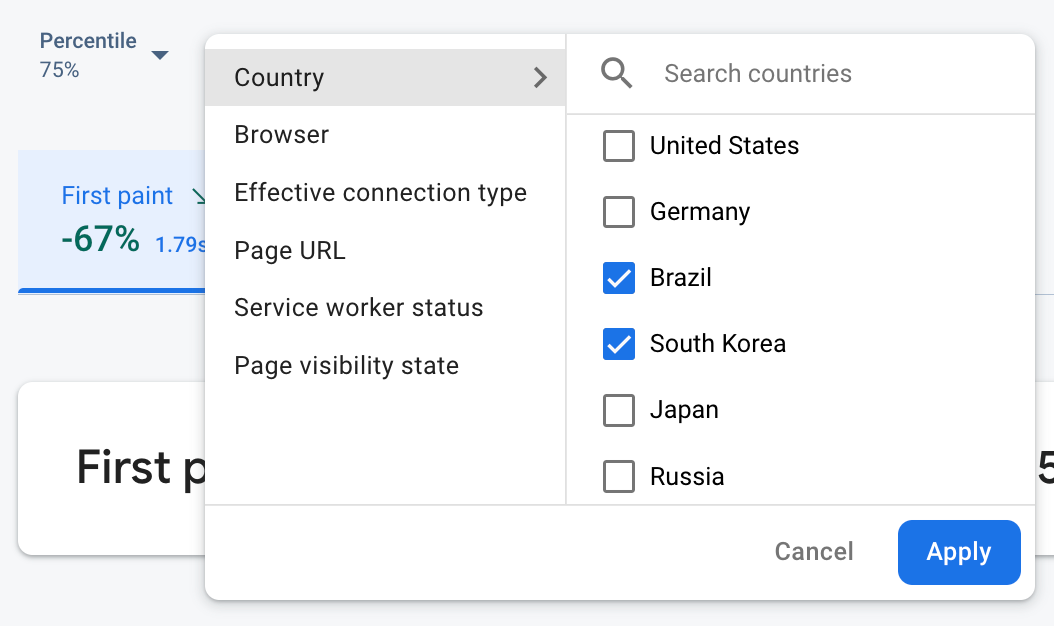Con Performance Monitoring, puoi utilizzare gli attributi per segmentare i dati sul rendimento e concentrarti sul rendimento della tua app in diversi scenari reali.
Dopo aver fatto clic sul nome di una traccia nella tabella delle tracce (situata nella parte inferiore
della
dashboard Rendimento), puoi esaminare in dettaglio le
metriche di interesse. Utilizza il pulsante
 Dati di Firebase Performance Monitoring filtrati per attributo" />
Dati di Firebase Performance Monitoring filtrati per attributo" />
- Filtra per URL pagina per visualizzare i dati di una pagina specifica del tuo sito.
- Filtra per Tipo effettivo di connessione per scoprire in che modo una connessione 3G influisce sulla tua app
- Filtra per Paese per assicurarti che la posizione del database non influisca su una regione specifica.
Attributi predefiniti
Performance Monitoring raccoglie automaticamente una serie di attributi predefiniti a seconda del tipo di traccia.
Oltre a questi attributi predefiniti, puoi anche creare attributi personalizzati nelle tracce di codice personalizzato per segmentare i dati in base a categorie specifiche per la tua app. Ad esempio, in un gioco, puoi segmentare i dati in base al livello di gioco.
Attributi predefiniti raccolti per le app web
Tutte le tracce per le app web raccolgono i seguenti attributi per impostazione predefinita:
- Browser
- Paese
- Tipo effettivo di connessione
- URL pagina
- Stato del service worker
- Stato visibilità
Raccolta dei dati utente
Creare attributi personalizzati
Puoi creare attributi personalizzati in qualsiasi delle tue tracce di codice personalizzato instrumentate.
Utilizza l'API Trace Performance Monitoring per aggiungere attributi personalizzati alle tracce di codice personalizzato.
Per utilizzare gli attributi personalizzati, aggiungi alla tua app un codice che definisca l'attributo e lo associ a una traccia di codice personalizzato specifica. Puoi impostare l'attributo personalizzato in qualsiasi momento tra l'inizio e la fine della traccia.
Tieni presente quanto segue:
I nomi degli attributi personalizzati devono soddisfare i seguenti requisiti:
- Nessuno spazio vuoto iniziale o finale, nessun carattere di sottolineatura iniziale (
_) - Nessuno spazio
- La lunghezza massima è di 32 caratteri
- I caratteri consentiti per il nome sono
A-Z,a-ze_.
- Nessuno spazio vuoto iniziale o finale, nessun carattere di sottolineatura iniziale (
Ogni traccia di codice personalizzato può registrare fino a 5 attributi personalizzati.
Assicurati che gli attributi personalizzati non contengano informazioni che identifichino personalmente un individuo per Google.
Scopri di più su questa linea guida
Web
import { trace } from "firebase/performance"; const t = trace(perf, "test_trace"); t.putAttribute("experiment", "A"); // Update scenario t.putAttribute("experiment", "B"); // Reading scenario const experimentValue = t.getAttribute("experiment"); // Delete scenario t.removeAttribute("experiment"); // Read attributes const traceAttributes = t.getAttributes();
Web
const trace = perf.trace("test_trace"); trace.putAttribute("experiment", "A"); // Update scenario trace.putAttribute("experiment", "B"); // Reading scenario const experimentValue = trace.getAttribute("experiment"); // Delete scenario trace.removeAttribute("experiment"); // Read attributes const traceAttributes = trace.getAttributes();

